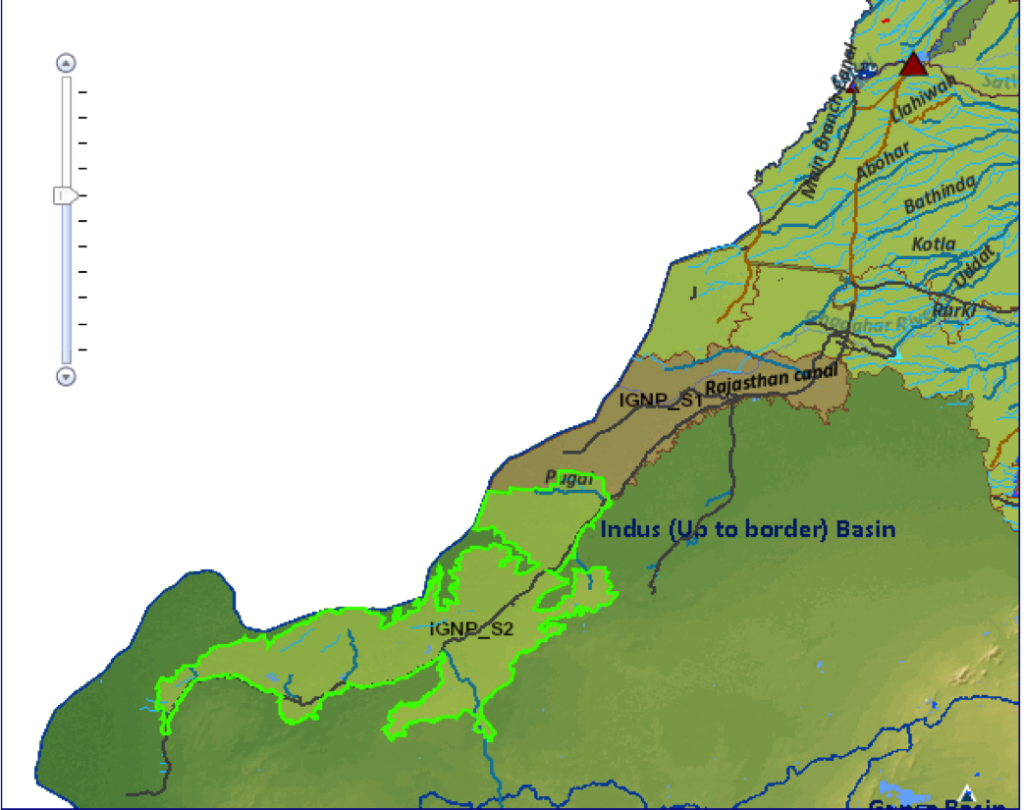One of the most interesting feature about drainage system of Rajasthan is that nearly 60.2 percent of of the area of state has inland drainage system. Nearly all of this area lies wet of Aravalli divide and includes a large number of separate basins like Sota-Sahibi basin, Kantli basin, Barah Basin and streams in Luni basin.
Ghaggar-Hakra River
Ghaggar-Hakra River is a season river in India and Pakistan that flows only during the monsoon season. The river originates from kalka hills (Himachal Pradesh) and is known as Ghaggar before the Ottu barrage and as the Hakra downstream of the barrage.
Ghaggar-Hakra River Summary Sheet
| Origin | Kalka Hills of Shivalik Range in Himachal Pradesh | |||
|---|---|---|---|---|
| Length | 465 Kms | |||
| Discharge | Sand dunes in Bhawalpur district of Pakistan | |||
| States & Major Cities | Himachal Pradesh: Punjab: Ambala, Patiala Haryana: Hissar Rajasthan: Tibbi, Hanumangarh, Talwara, Anupgarh and Suratgarh |
|||
| Tributaries | Chautang River, Kaushalya river, Sarsuti | |||
Ghaggar Hakra River Course:
Ghaggar rises from Kalka hills of Shivalik Range in Himachal Pradesh and flows through Ambala, Patiala (Punjab) and Hissar (Haryana) districts. It enters Rajasthan and flows through Hanumangarh, Talwara, Anupgarh and Suratgarh. Ghaggar flows across the international border through Sri Ganganagar district and assumes the name, Hakra, near Fort Abbas City in Pakistan. The river finally enters into Bhawalpur district of Pakistan where it gets lost in sand dunes.
Ghaggar in History-Culture
- Few scholars identify Ghaggar with the vedic river of saraswati. (Details)
Kantli River:
- Kantli river originates from hills of Khandela hills of Sikar district and taking a northernly course runs into Jhunjhunu and ends in sand dunes near Churu district.
- Site of ancient OCP culture – Ganeshwar lies on bank of Kantli river.
- Catchment area of Kantli river is known as Torawati.
Kakni or Masurdi River:
- Kakni is a small seasonal river of Jaisalmer, that originates 27 south from Kotri village and flows for few kms draining into Bhuj lake.
Mantha River:
- Mantha river orginates from jaipur and flows into Sambhar lake.
Ruparel River or Ruparail River
- Ruparel river originates from Udainath hills in Thangazi tehsil of Alwar district.
- It traverses these hills northwards, turning towards the east and northeast before disappearing in Bharatpur District. It flows first through hills and subsequently through plains nearly up to Kusalpur in Bharatpur district.
- It has a total length of about 104 km.
- Also called as Varah or Lasvari river.
- Ruparail basin extends in a broadly W-E direction and is bounded by the Sabi River Basins in the northwest side and the Banganga River Basin in the southeast. The northern border is shared with Haryana State.
- The river has been in news, because of its disappearance and revival by efforts of Shri Rajendra Singh (Readmore)
Rupangarh River
- Rupangarh river originates from Salemabad (Ajmer) and flows in northerly direction to drain into Sambhar lake.
Sota-Sabi or Sahibi River
- There are two branches, the Sabi branch rises from Sewar hills and the Sota branch rises from hills of Bairath.
- The two branches meet at Jalalpur.
- The river flows in northern direction through Kotputli tehsil, Bansur, Behror Kishangarh, Mundawar (Haryana) Rewari and empties into Najafgarh drain.
- Sabi basin is bounded in the northwest by Shekhawati River Basin and Ruparail and Banganga River basins in the southeast. The northern boundary is shared administratively with Haryana State. The Basin extends over parts of Alwar, Jaipur and Sikar districts. The total catchment area of the sabi basin is 4607.9 km2.
- It flows in Rajasthan for a distance of about 157 km before entering Haryana State.
Sabi River in History & Culture:
Several modern scholars identify the Sahibi River with the Drishadvati river of Vedic period. It is believed that the Drishadwati River had formed one border of the Vedic state of Brahmavarta while other was Saraswati river or the modern Ghaggar-Hakra river.
Several sites related to Indus Valley civilisation have been found along the route of Sahibi. Among the finds are handmade and wheel-made pottery dating back to over 3,000 years found on the banks of the Sahibi River at Jodhpura near Viratnagar in Jaipur district. Other findings include pottery found on the Sahibi riverbed at Hansaka in the Rewari district, Haryana. A red stone statute of Vamana Dev was unearthed in 2002 on the Sahibi riverbed near Bawal, Haryana.





